Theoretical Deduction of the Optimum Tilt Angles for Small-Scale Linear Fresnel Reflectors
Abstract
1. Introduction
2. Overview
3. Theoretical Justification of the Optimum Tilt Angles
3.1. Influence of over A and Influence of over E
3.2. Calculation of the Optimum
3.3. Calculation of the Optimum
4. Results and Discussion
5. Conclusions
6. Annex
Author Contributions
Funding
Institutional Review Board Statement
Informed Consent Statement
Data Availability Statement
Acknowledgments
Conflicts of Interest
Abbreviations
| Effective area of the absorber tube (m) | |
| Cleanliness factor of the glass | |
| Cleanliness factor of the mirror | |
| D | Diameter of the absorber tube (m) |
| Direct Normal Irradiance (W/m) | |
| d | Separation between two consecutive mirrors (m) |
| Ratio between the annual energy absorbed and the area required for the | |
| installation (Mwh/m) | |
| f | Height of the receiver (m) |
| Incidence angle modifier | |
| L | Reflector length (m) |
| Length of the mirrors (m) | |
| Length of the single absorber tube (m) | |
| Left length of the single absorber tube (m) | |
| Right length of the single absorber tube (m) | |
| Total illuminated length of the absorber tube. (m) | |
| Left illuminated length of the absorber (m) | |
| Right illuminated length of the absorber (m) | |
| Length of the circumference illuminated on the absorber tube by the i-th mirror (m) | |
| n | Number of mirrors at each side of the central mirror |
| Ordinal of the day | |
| Q | Total power absorbed (W) |
| W | Mirror field width (m) |
| Width of the mirrors (m) | |
| Width illuminated on the absorber by the i-th by mirror (m) | |
| Absorptivity of the absorber tube | |
| Angle between the vertical at the focal point and the line connecting the center | |
| point of each mirror to the focal point () | |
| Height angle of the Sun () | |
| Angle between the absorber tube and the horizontal plane () | |
| Tilt of i-th mirror () | |
| Angle between the mirror axis and the horizontal plane () | |
| Azimuth of the Sun () | |
| Declination () | |
| Optical efficiency (%) | |
| Zenith angle of the Sun () | |
| Latitude angle () | |
| Reflectivity of the primary mirrors | |
| Angle between the reflected ray and the normal to the NS axis () | |
| Day angle () | |
| Transmissivity of the glass | |
| Hour angle () |
References
- EUROSTAT. Eurostat, Energy Statistics—An Overview. 2017. Available online: https://ec.europa.eu/eurostat/statistics-explained/index.php?title14Energy_statistics_-_an_overview#Energy_intensity (accessed on 15 April 2021).
- European Commission. Energy-Heating and Cooling. 2018. Available online: https://ec.europa.eu/energy/en/topics/energyefficiency/heating-and-cooling (accessed on 15 April 2021).
- European Council Report. 2019. Available online: http://www.consilium.europa.eu/uedocs/cms_data/docs/pressdata/en/ec/145397.pdf (accessed on 15 April 2021).
- Buker, M.S.; Riffat, S.B. Building integrated solar thermal collectors—A review. Renew. Sustain. Energy Rev. 2015, 51, 327–346. [Google Scholar] [CrossRef]
- Mokhtar, G.; Boussad, B.; Noureddine, S. A linear Fresnel reflector as a solar system for heating water: Theoretical and experimental study. Case Stud. Therm. Eng. Case 2016, 8, 176–186. [Google Scholar] [CrossRef]
- Serag-Eldin, M.A. Thermal design of a roof-mounted CLFR collection system for a desert absorption chiller. Int. J. Sustain. Energy 2014, 33, 506–524. [Google Scholar] [CrossRef]
- Velázquez, N.; García-Valladares, O.; Sauceda, D.; Beltrxaxn, R. Numerical simulation of a Linear Fresnel Reflector Concentrator used as direct generator in a Solar-GAX cycle. Energy Convers. Manag. 2010, 51, 434–445. [Google Scholar] [CrossRef]
- Zhou, L.; Li, X.; Zhao, Y.; Dai, Y. Performance assessment of a single/double hybrid effect absorption cooling system driven by linear Fresnel solar collectors with latent thermal storage. Sol. Energy 2017, 151, 82–94. [Google Scholar] [CrossRef]
- Montenon, A.C.; Papanicolas, C. Economic assessment of a PV hybridized linear Fresnel collector supplying air conditioning and electricity for buildings. Energies 2021, 14, 131. [Google Scholar] [CrossRef]
- Boito, P.; Grena, R. Application of a fixed-receiver linear Fresnel reflector in concentrating photovoltaics. Sol. Energy 2021, 215, 198–205. [Google Scholar] [CrossRef]
- Barbón, A.; Sánchez-Rodríguez, J.A.; Bayxoxn, L.; Barbxoxn, N. Development of a fiber daylighting system based on a small-scale linear Fresnel reflector: Theoretical elements. Appl. Energy 2018, 212, 733–745. [Google Scholar] [CrossRef]
- Barbón, A.; Barbxoxn, N.; Bayxoxn, L.; Otero, J.A. Optimization of the length and position of the absorber tube in small-scale Linear Fresnel Concentrators. Renew. Energy 2016, 99, 986–995. [Google Scholar] [CrossRef]
- Barbón, A.; Bayxoxn, L.; Bayxoxn-Cueli, C.; Barbxoxn, N. A study of the effect of the longitudinal movement on the performance of small scale linear Fresnel reflectors. Renew. Energy 2019, 138, 128–138. [Google Scholar] [CrossRef]
- Barbón, A.; Bayxoxn-Cueli, C.; Bayxoxn, L.; Rodríguez, L. Investigating the influence of longitudinal tilt angles on the performance of small scale linear Fresnel reflectors for urban applications. Renew. Energy 2019, 143, 1581–1593. [Google Scholar] [CrossRef]
- Nixon, J.D.; Davies, P.A. Construction and experimental study of an elevation linear Fresnel reflector. J. Sol. Energy Eng. 2016, 138, 031001. [Google Scholar] [CrossRef]
- Pulido-Iparraguirre, D.; Valenzuela, L.; Serrano-Aguilera, J.J.; Fernández-García, A. Optimized design of a Linear Fresnel reflector for solar process heat applications. Renew. Energy 2019, 131, 1089–1096. [Google Scholar] [CrossRef]
- Barbón, A.; Sánchez-Rodríguez, J.A.; Bayxoxn, L.; Bayxoxn-Cueli, C. Cost estimation relationships of a small-scale linear Fresnel reflector. Renew. Energy 2019, 134, 1273–1284. [Google Scholar] [CrossRef]
- Spencer, J.W. Fourier series representation of the position of the sun. Search 1971, 2, 172. [Google Scholar]
- Barbón, A.; Ayuso, P.F.; Bayxoxn, L.; Fernández-Rubiera, J.A. Predicting beam and diffuse horizontal irradiance using Fourier expansions. Renew. Energy 2020, 154, 46–57. [Google Scholar] [CrossRef]
- PVGIS. Joint Research Centre (JRC). 2021. Available online: http://re.jrc.ec.europa.eu/pvg_tools/en/tools.html#PVP (accessed on 15 April 2021).
- Zhu, Y.; Shi, J.; Li, Y.; Wang, L.; Huang, Q.; Xu, G. Design and thermal performances of a scalable linear Fresnel reflector solar system. Energy Convers. Manag. 2017, 146, 174–181. [Google Scholar] [CrossRef]
- Zhu, Y.; Shi, J.; Li, Y.; Wang, L.; Huang, Q.; Xu, G. Design and experimental investigation of a stretched parabolic linear Fresnel reflector collecting system. Energy Convers. Manag. 2016, 126, 89–98. [Google Scholar] [CrossRef]
- Duffie, J.A.; Beckman, W.A. Solar Engineering of Thermal Processes, 4th ed.; John Wiley & Sons: New York, NY, USA, 2013. [Google Scholar]
- Sharma, V.; Khanna, S.; Nayak, J.K.; Kedare, S.B. Effects of shading and blocking in compact linear fresnel reflector field. Energy 2016, 94, 633–653. [Google Scholar] [CrossRef]
- Theunissen, P.H.; Beckman, W.A. Solar transmittance characteristics of evacuated tubular collectors with diffuse back reflectors. Sol. Energy 1985, 35, 311–320. [Google Scholar] [CrossRef]
- Kottek, M.; Grieser, J.; Beck, C.; Rudolf, B.; Rubel, F. World map of the Köppen-Geiger climate classification updated. Meteorol. Z. 2006, 15, 259–263. [Google Scholar] [CrossRef]
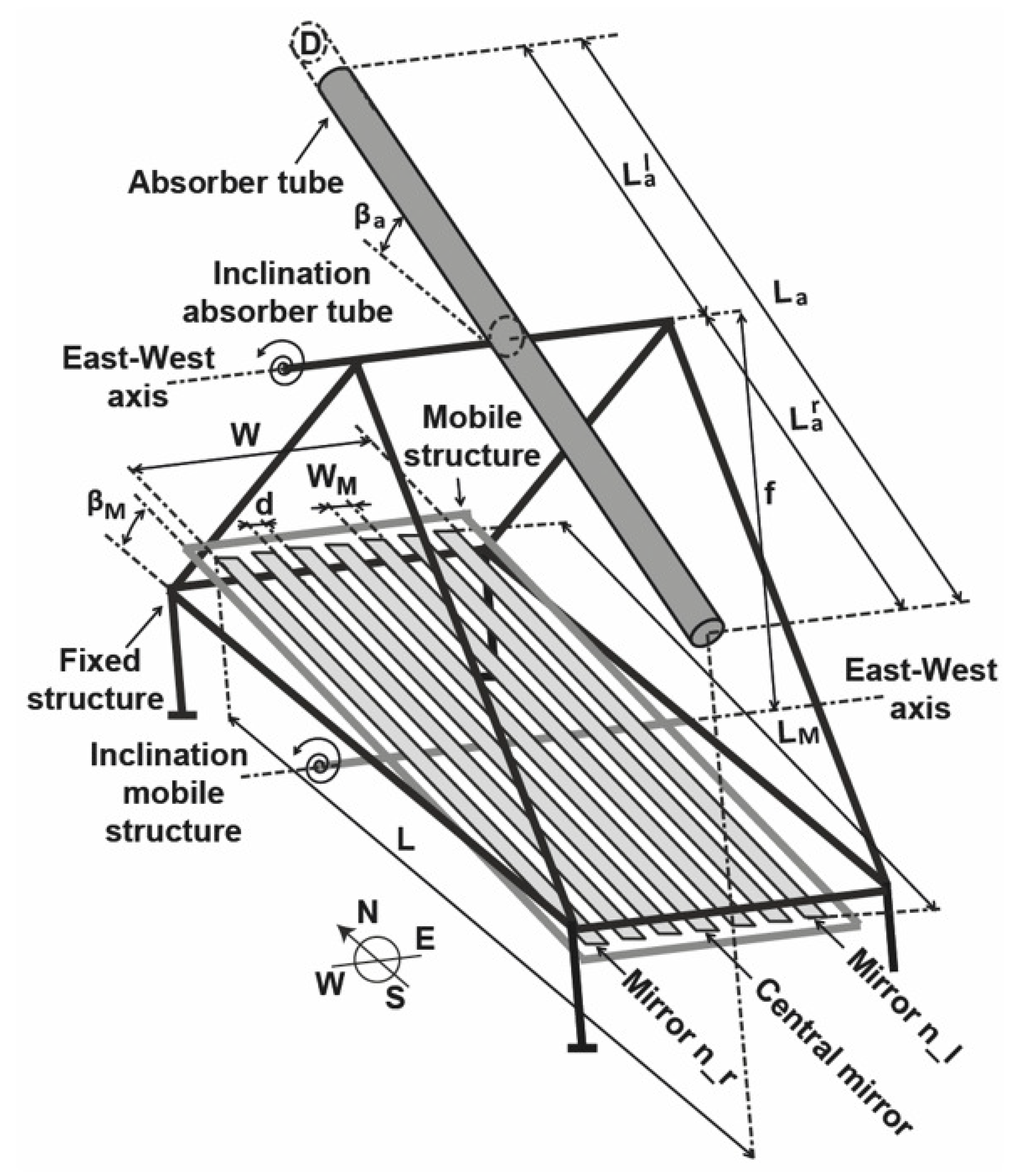

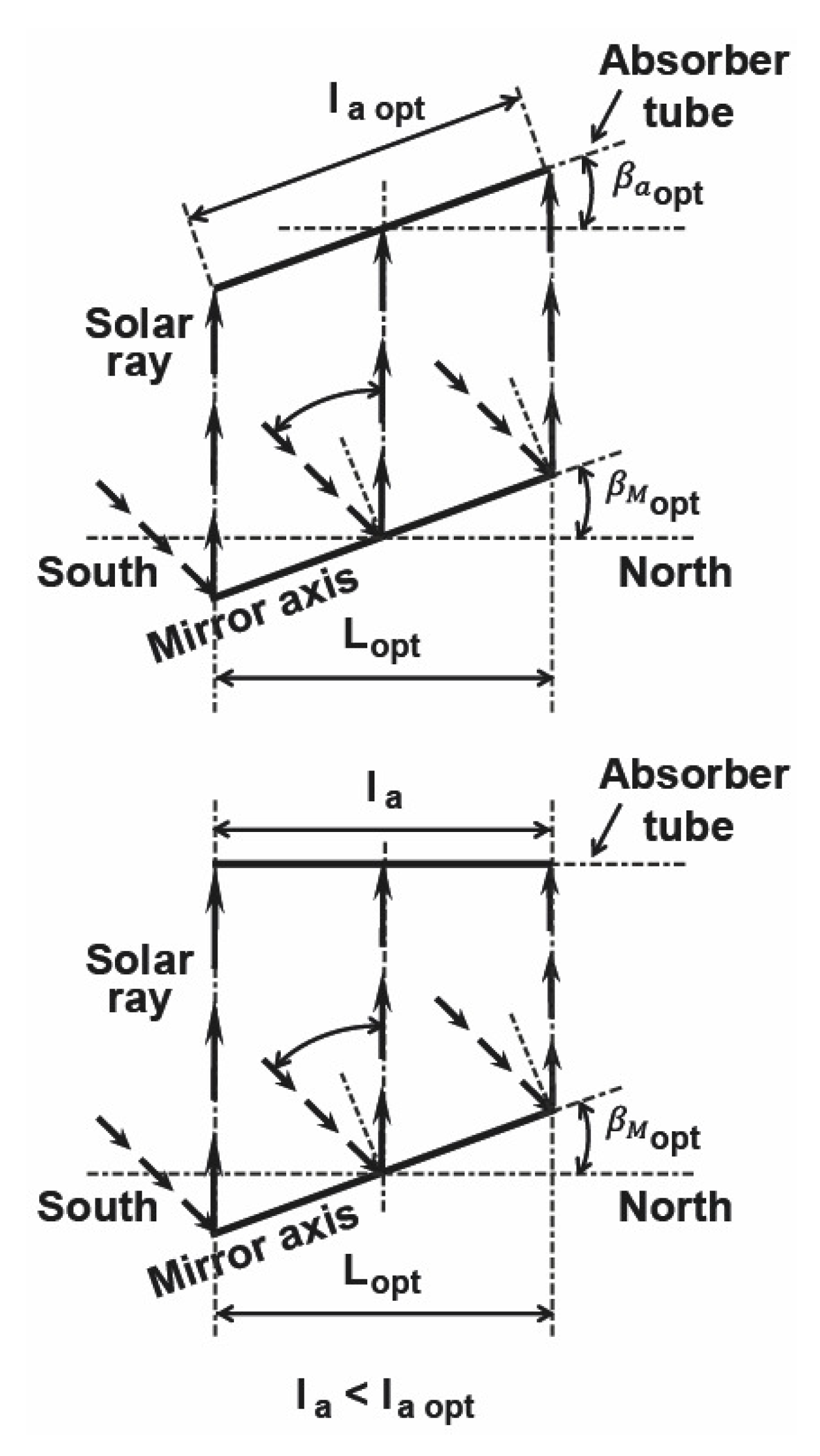
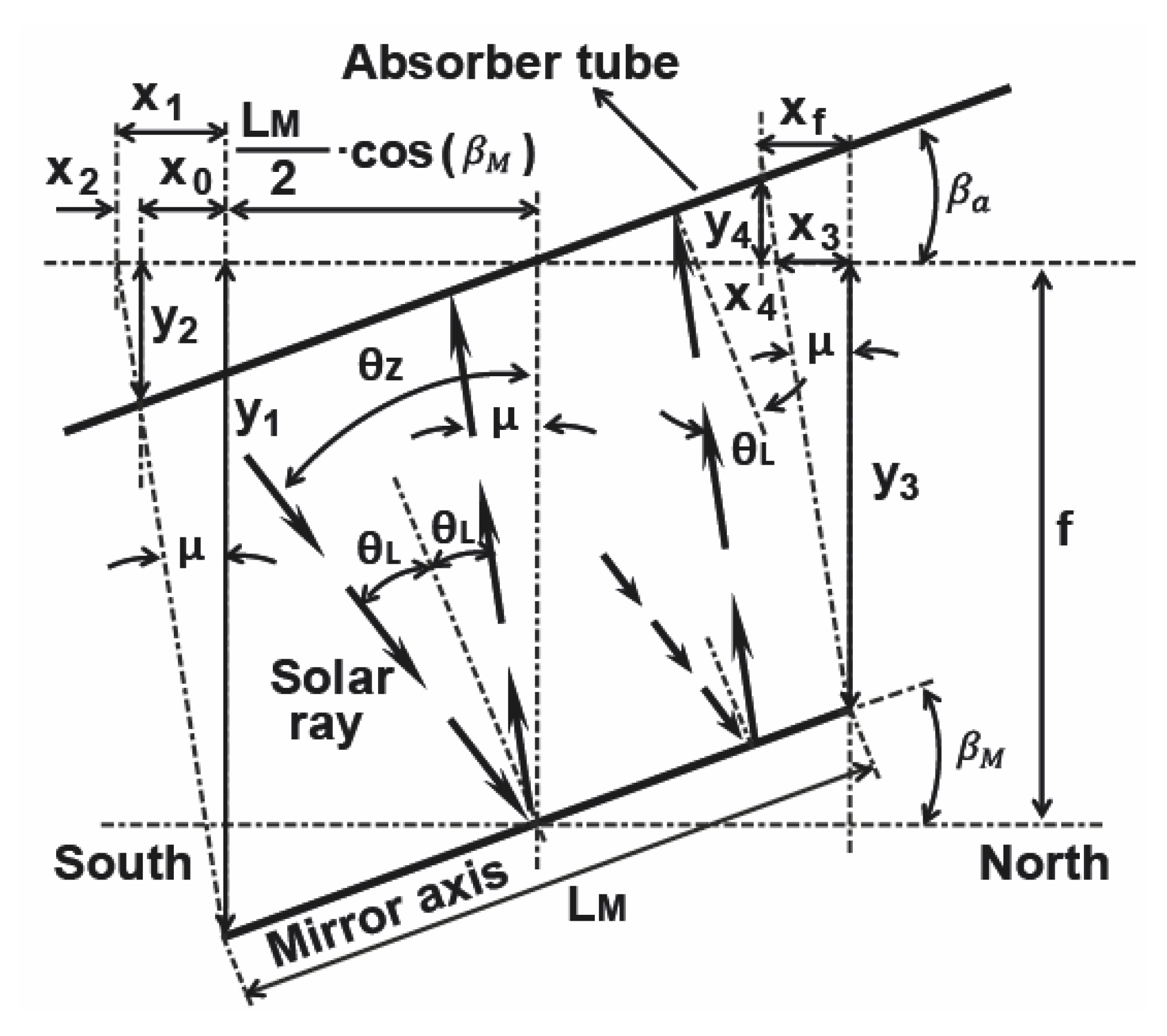
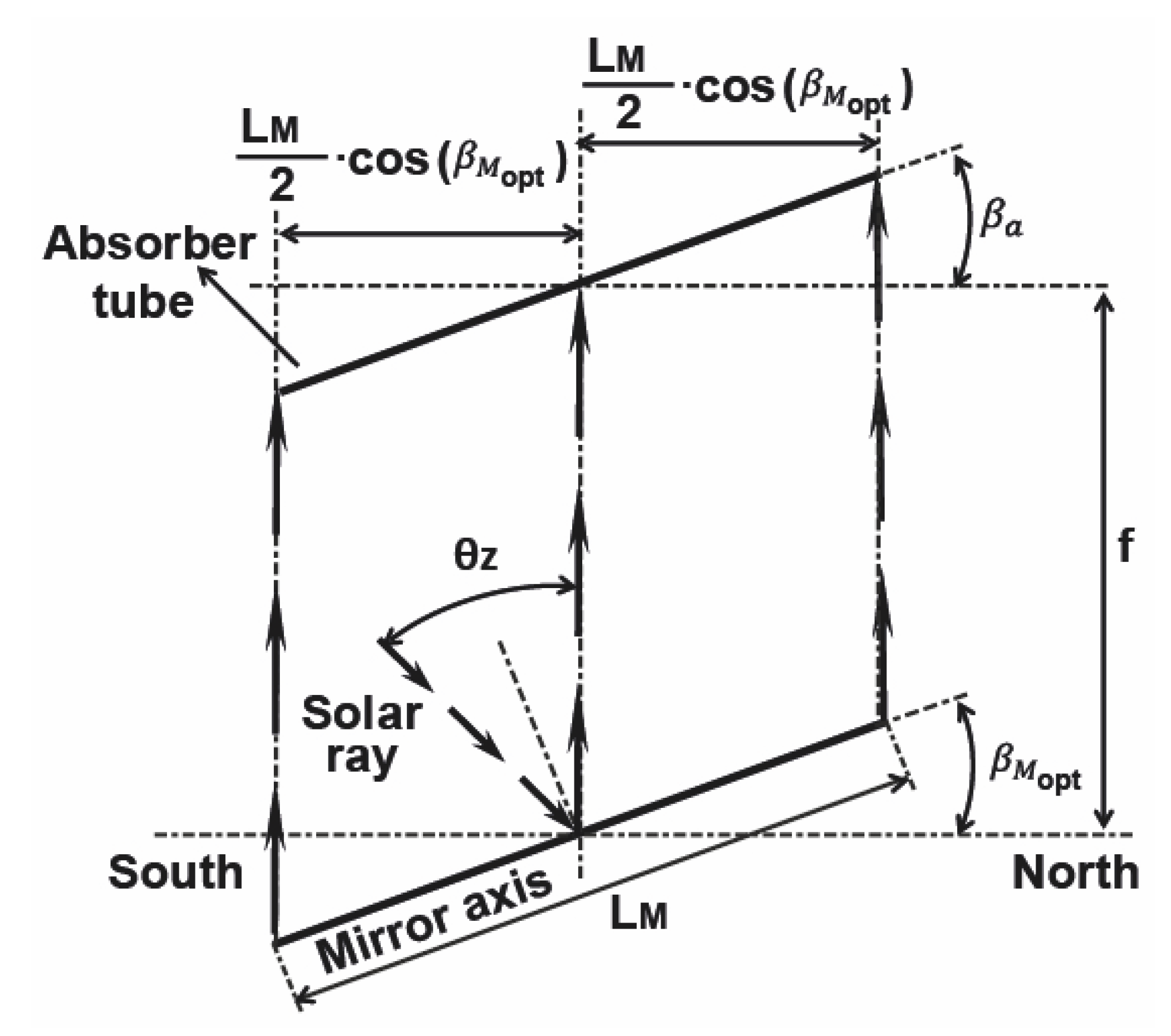

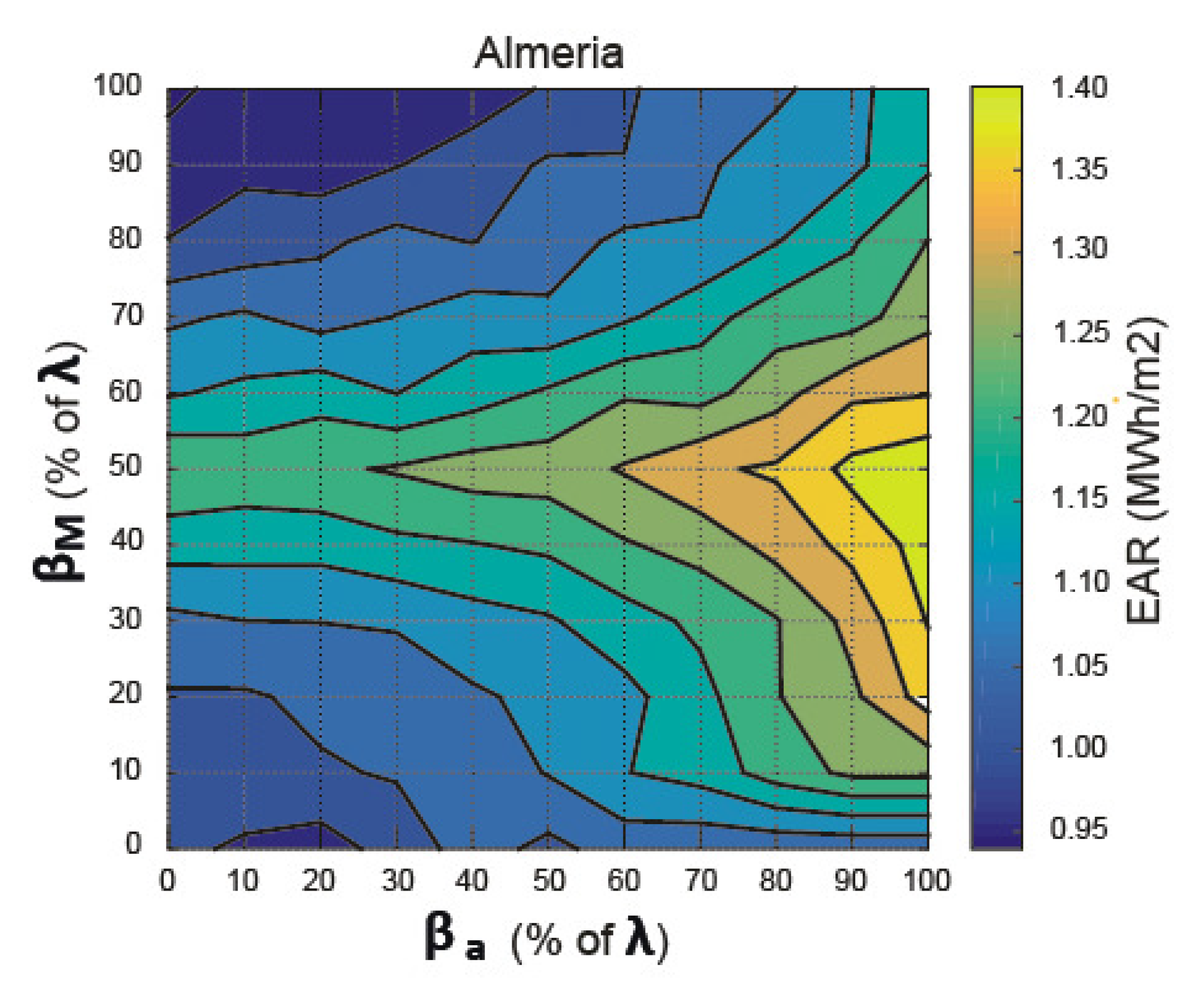
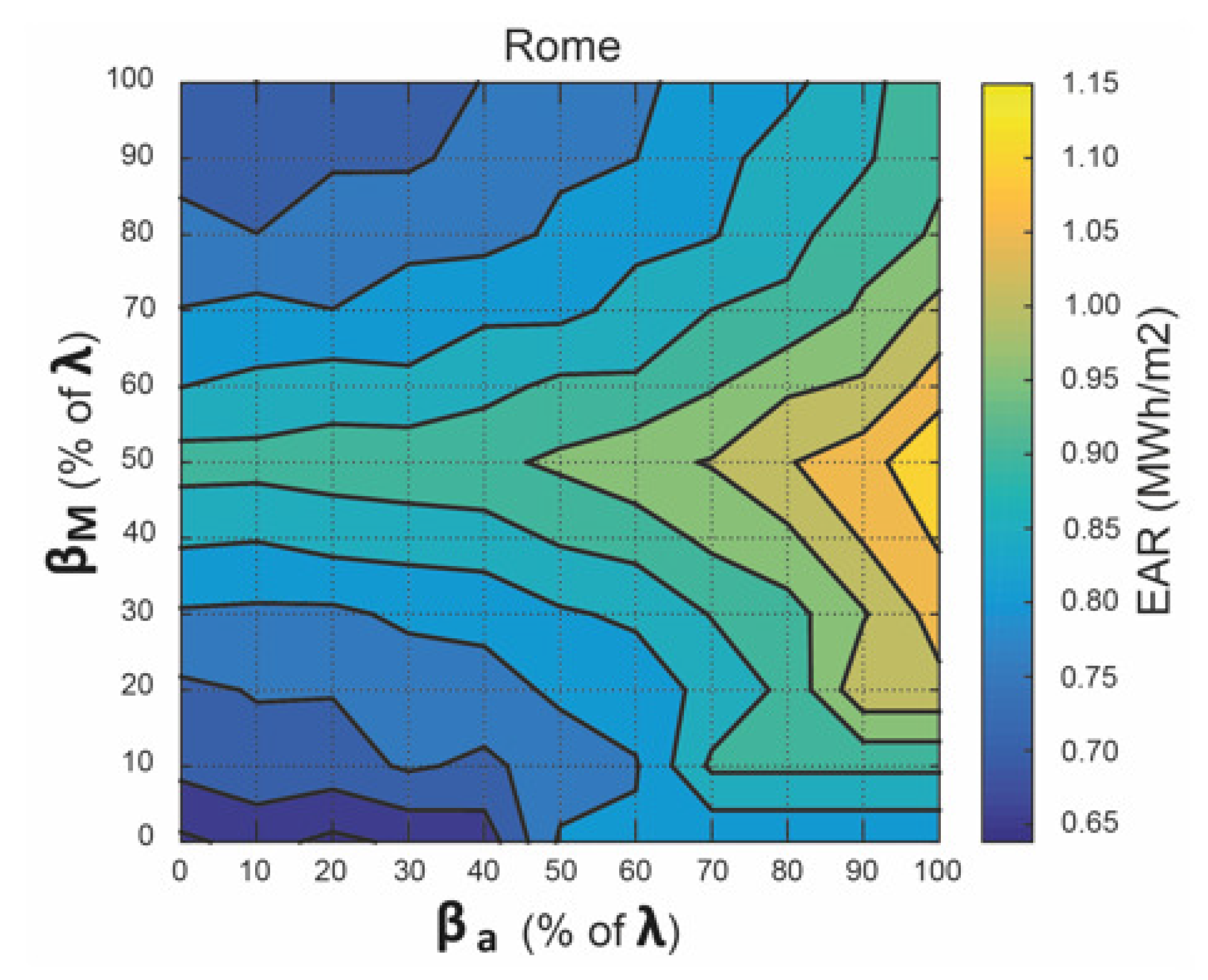
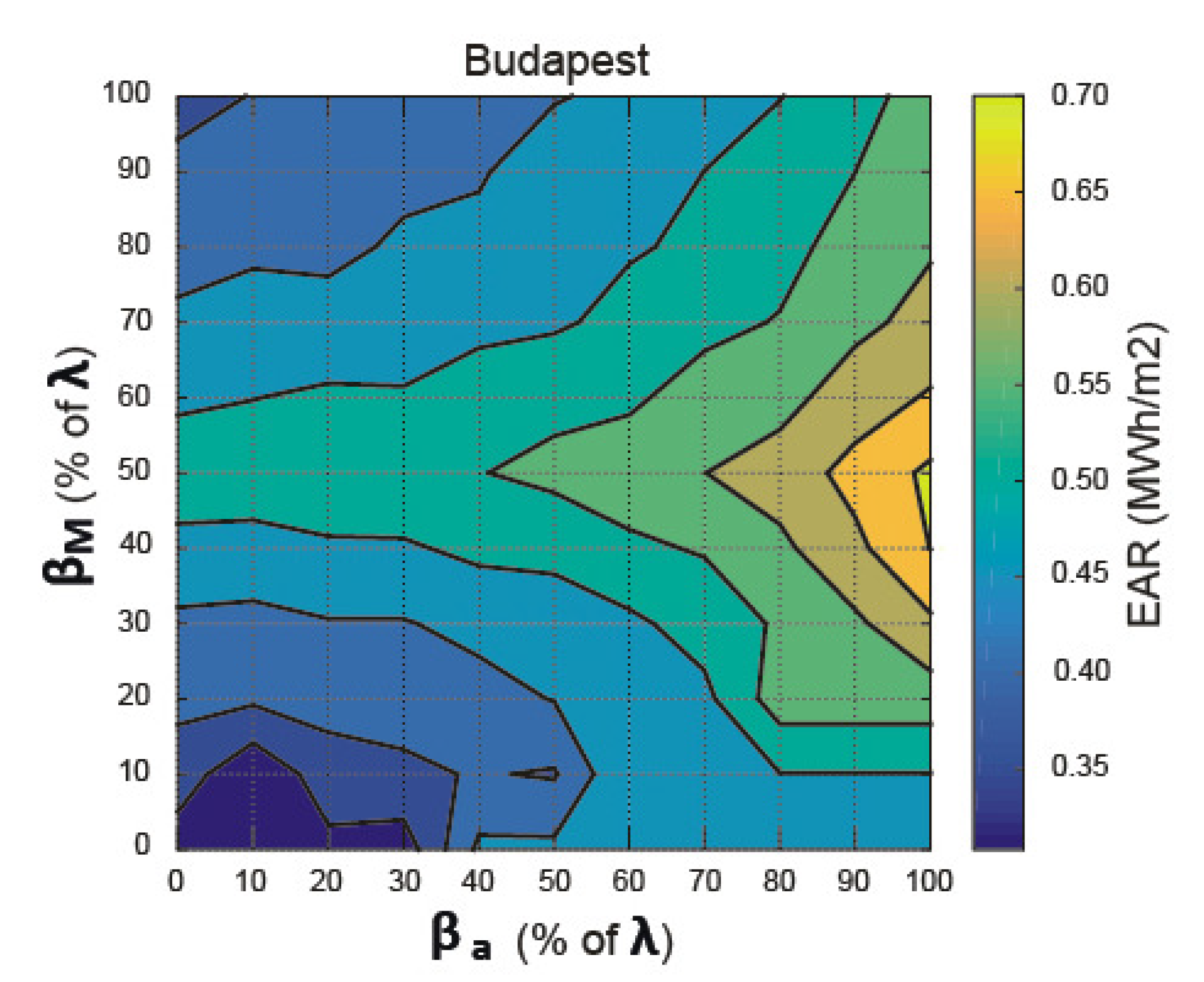
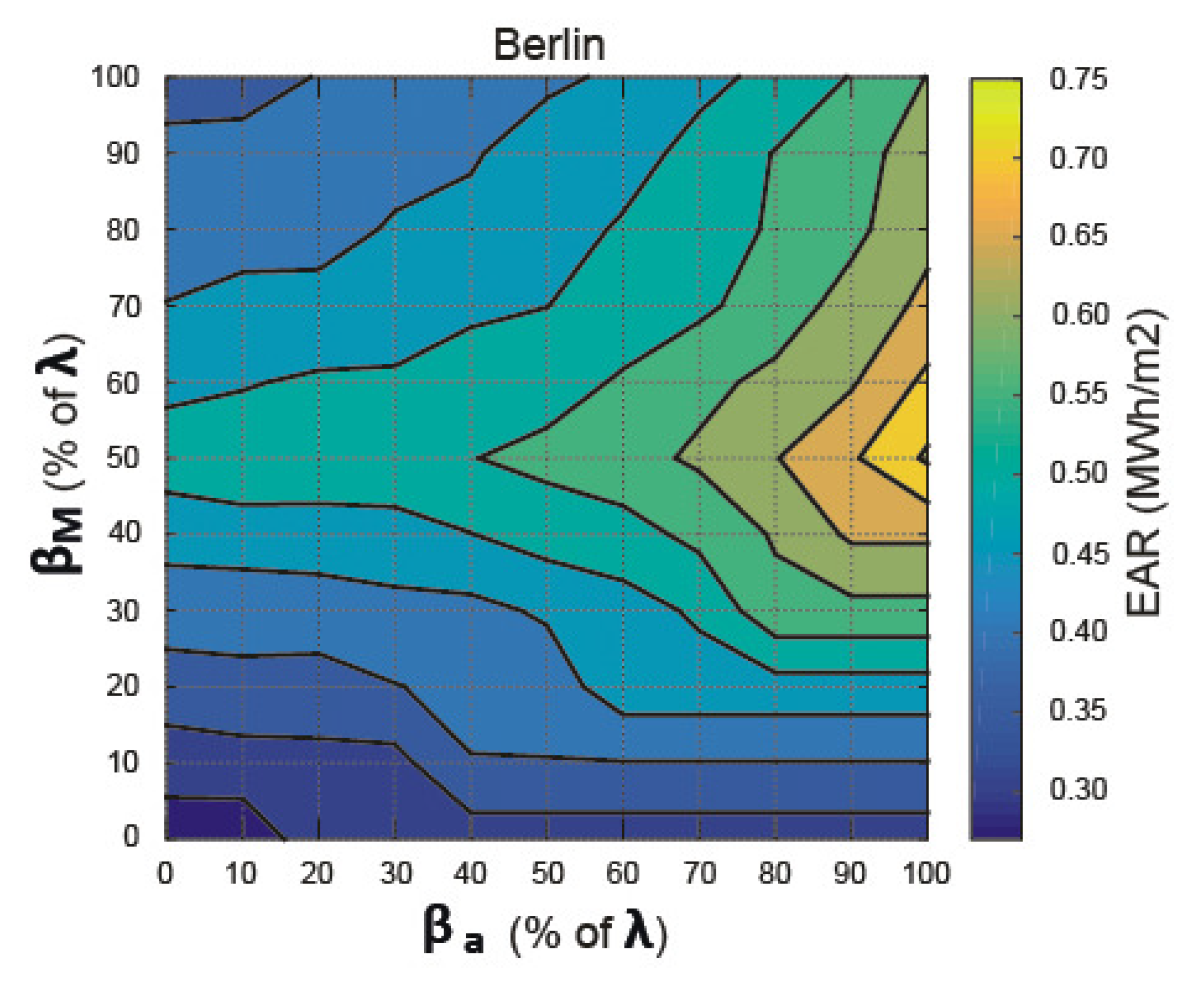
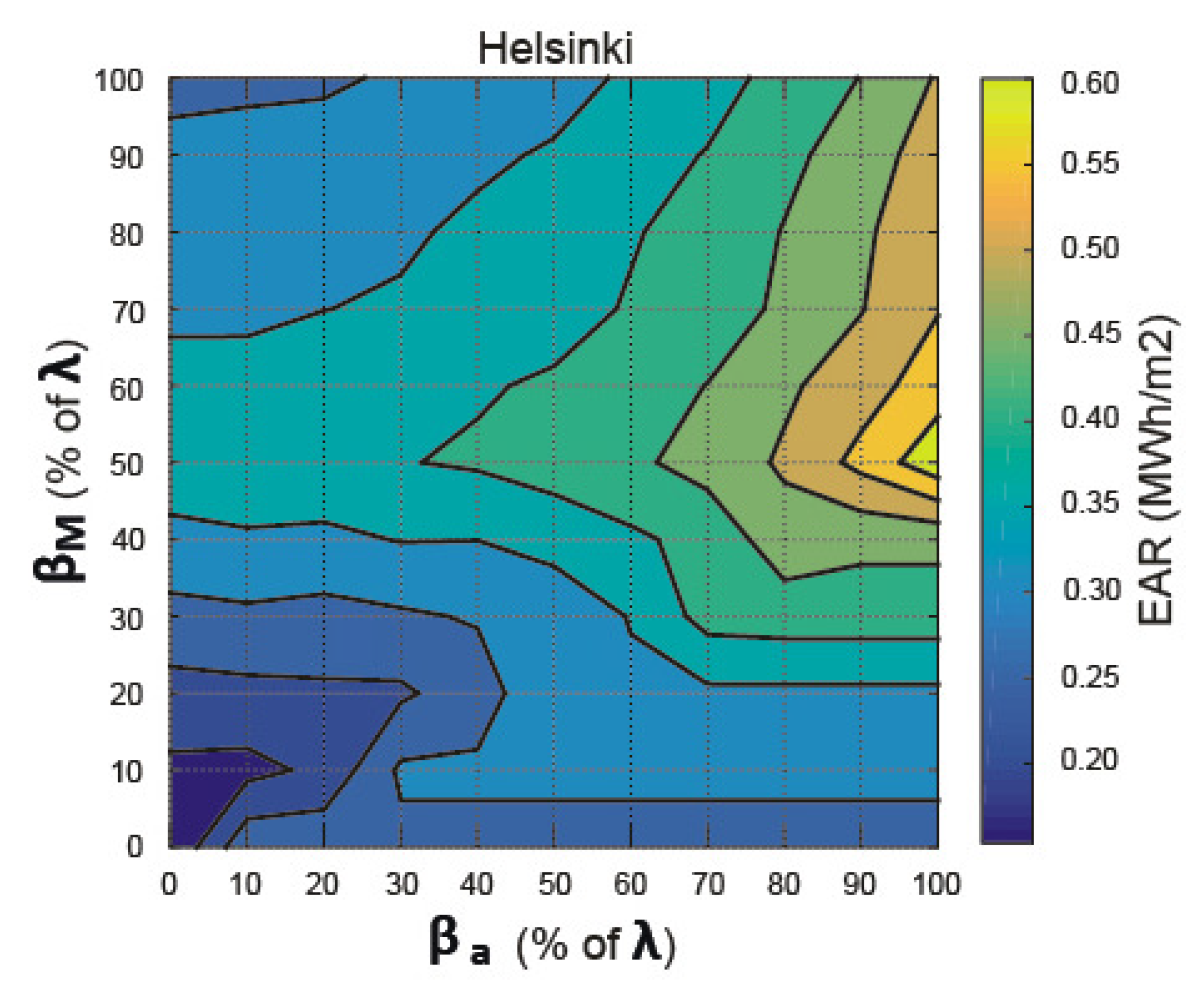
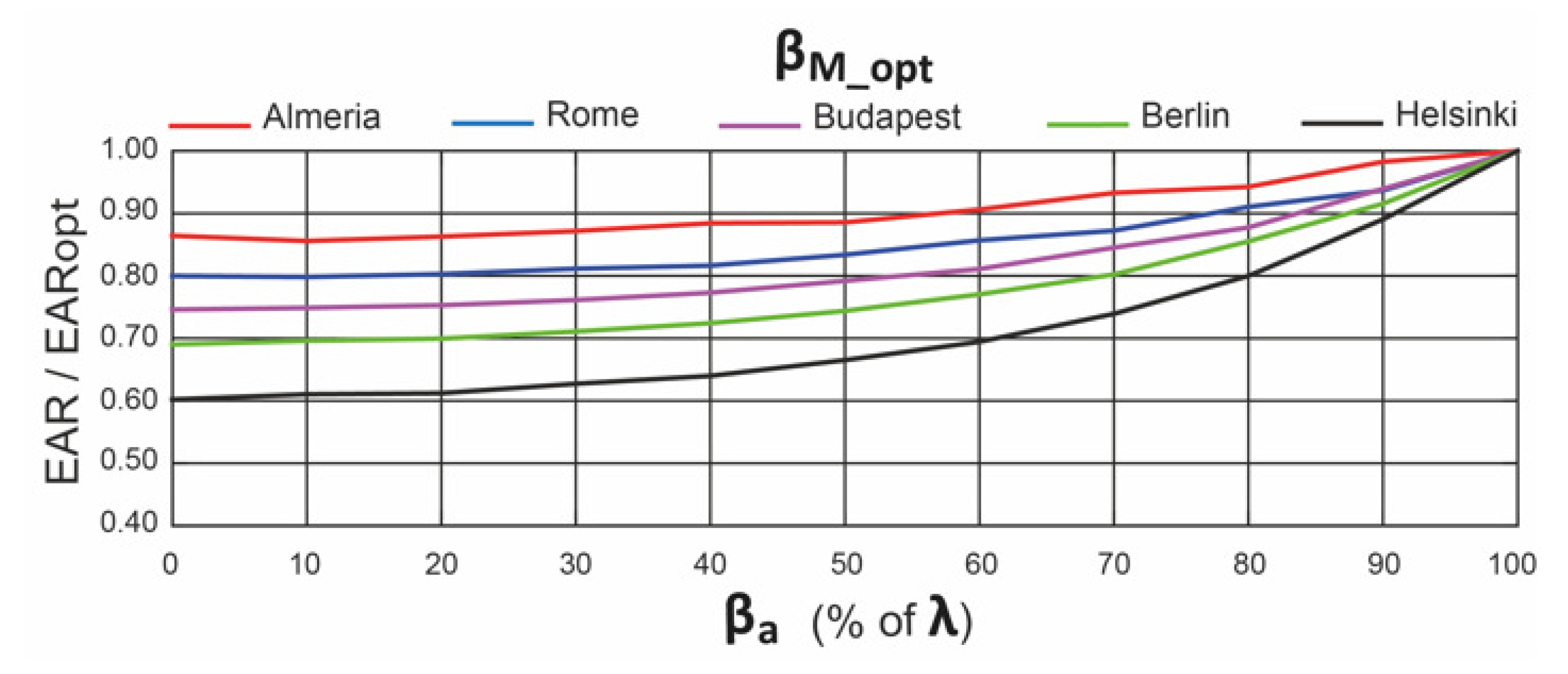
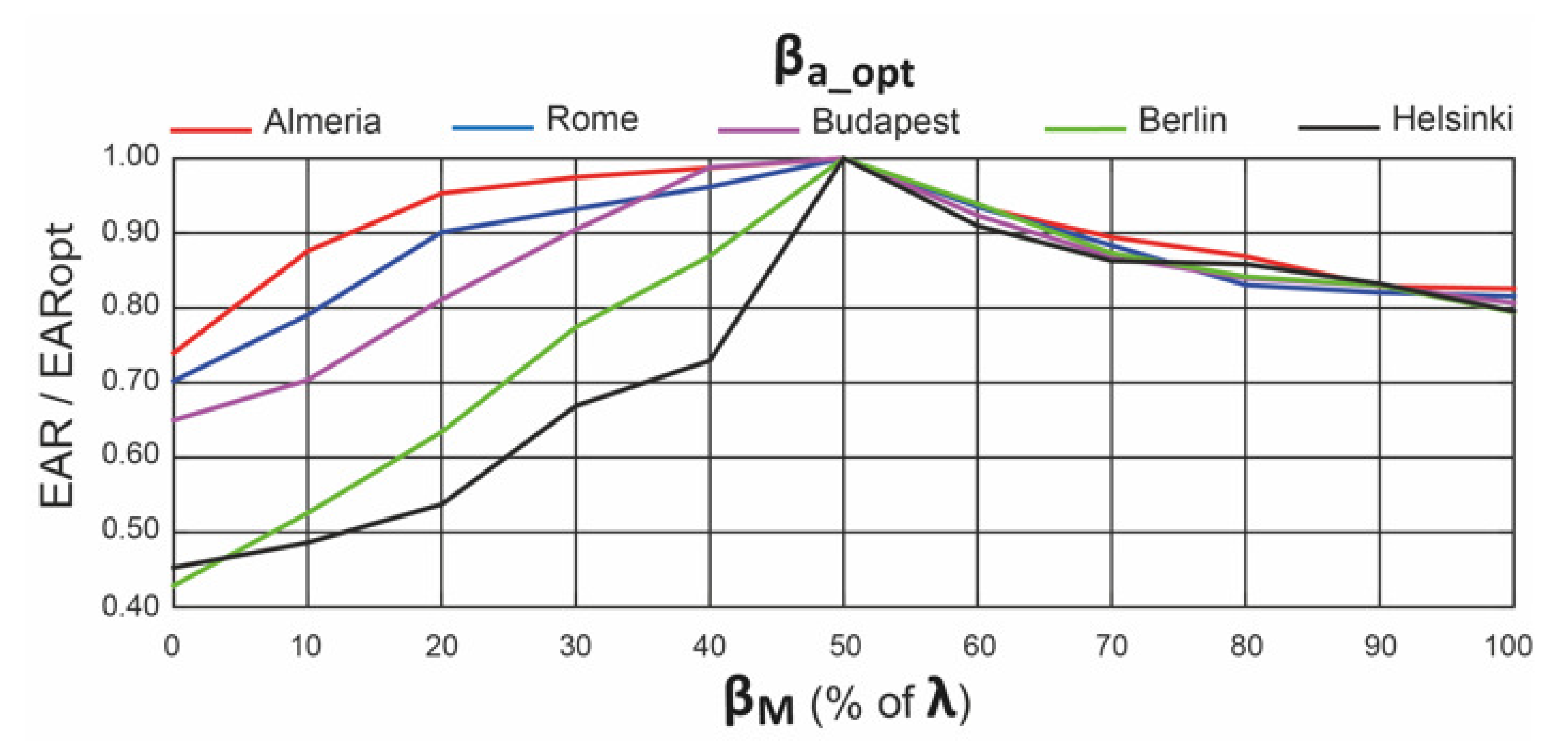
| Param. | Value | References |
|---|---|---|
| n | 12 | [12,14] |
| [12,14,21] | ||
| d | [12,14] | |
| D | [12,14] | |
| f | [12,14,21,22] | |
| L | [12,14] | |
| [23] | ||
| [24] | ||
| [24] | ||
| [25] () | ||
| [25] ( ) |
| Zone | Cities | Köppen [26] |
|---|---|---|
| Zone 1 | Athens, Larnaca-Luga-Catania-Almeria-Palermo | |
| Zone 2 | Lisbon-Madrid-Marseille-Rome | |
| Zone 3 | Bratislava-Budapest-Ljubljana-Milan-Venice | |
| Zone 4 | Amsterdam-Berlin-Brussels-Copenhagen-Dublin-London-Macon-Nancy-Paris-Prague-Warszawa | |
| Zone 5 | Helsinki-Riga-Stockholm-Gdansk-Tovarene |
| Zone | Cities | Latitude | Longitude | Altitude |
|---|---|---|---|---|
| Zone 1 | Almeria (Spain) | N | W | 22 (m) |
| Zone 2 | Rome (Italy) | N | E | 52 (m) |
| Zona 3 | Budapest (Hungary) | N | E | 111 (m) |
| Zone 4 | Berlin (Germany) | N | E | 37 (m) |
| Zone 5 | Helsinki (Finland) | N | E | 26 (m) |
Publisher’s Note: MDPI stays neutral with regard to jurisdictional claims in published maps and institutional affiliations. |
© 2021 by the authors. Licensee MDPI, Basel, Switzerland. This article is an open access article distributed under the terms and conditions of the Creative Commons Attribution (CC BY) license (https://creativecommons.org/licenses/by/4.0/).
Share and Cite
Barbón, A.; Bayón-Cueli, C.; Fernández Rubiera, J.A.; Bayón, L. Theoretical Deduction of the Optimum Tilt Angles for Small-Scale Linear Fresnel Reflectors. Energies 2021, 14, 2883. https://doi.org/10.3390/en14102883
Barbón A, Bayón-Cueli C, Fernández Rubiera JA, Bayón L. Theoretical Deduction of the Optimum Tilt Angles for Small-Scale Linear Fresnel Reflectors. Energies. 2021; 14(10):2883. https://doi.org/10.3390/en14102883
Chicago/Turabian StyleBarbón, Arsenio, Covadonga Bayón-Cueli, José A. Fernández Rubiera, and Luis Bayón. 2021. "Theoretical Deduction of the Optimum Tilt Angles for Small-Scale Linear Fresnel Reflectors" Energies 14, no. 10: 2883. https://doi.org/10.3390/en14102883
APA StyleBarbón, A., Bayón-Cueli, C., Fernández Rubiera, J. A., & Bayón, L. (2021). Theoretical Deduction of the Optimum Tilt Angles for Small-Scale Linear Fresnel Reflectors. Energies, 14(10), 2883. https://doi.org/10.3390/en14102883






